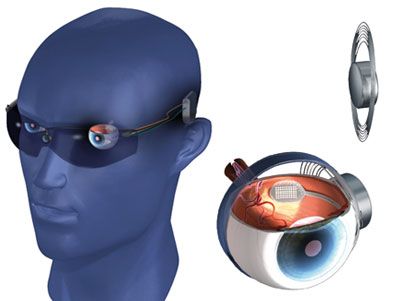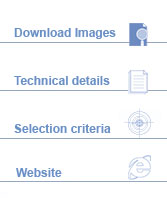|

WT AWARD 2009 - ACCESSIBILITY
Argus II Retinal Stimulation System
Second Sight Medical Products
 |

|
Protesi in grado di riabilitare alcune funzioni visive in soggetti con gravi disabilità causate da disturbi degenerativi della retina esterna. Il sistema consiste in una microcamera e un radio trasmettitore montati su un paio di comuni occhiali, un ricevitore e un dispositivo elettronico dotato di 60 elettrodi impiantati nella retina. Un video processore e un pacco batterie alimentano l’intero dispositivo. La fotocamera cattura un’immagine e il video processore la converte in un segnale elettronico e lo inoltra al trasmettitore montato sugli occhiali. Tale segnale arriva al ricevitore impiantato nella retina grazie alla tecnologia wireless e da qui passa agli elettrodi dove stimola l’emissione di impulsi elettrici. Gli impulsi inducono delle reazioni nella retina e attraverso il nervo ottico arrivano al cervello che li elabora in luci ed ombre corrispondenti agli elettrodi stimolati. Questo processo permette all’impiantato di vedere, anche se in maniera rudimentale: è constatato che i soggetti sottoposti a tale intervento arrivino a percepire la luce, se accesa o spenta, descrivere un oggetto in movimento e distinguere i diversi oggetti in un ambiente. Tuttavia il sistema lavora meglio con persone che hanno perduto la vista, poichè il loro cervello sa già come elaborare le informazioni che riceve.
Retinal prosthesis intended to restore some functional vision for people severely blinded by outer retinal degenerative diseases. The device consists of a tiny camera and radio transmitter mounted on a pair of glasses, an implanted receiver, and an electrode-studded array that is secured to the back of the eye by a micro-tack which is the width of a human hair. A video processor and battery pack worn on the belt powers the entire device. The camera on the glasses captures an image and sends the information to the video processor, which converts the image to an electronic signal and sends it to the transmitter on the sunglasses. The implanted receiver wirelessly receives this data and sends the signals through a tiny cable to the array of 60 electrodes, stimulating them to emit electrical pulses. The pulses induce responses in the retina that travel through the optic nerve to the brain, which perceives patterns of light and dark spots corresponding to the electrodes stimulated.The electrodes conduct informations acquired from the camera to the retina, providing on this way a rudimentary form of sight to implanted subjects.
As a matter of fact the patient becomes ableto detect when lights are on or off, describe an object’s motion, and locate and differentiate basic objects in an environment.
 |
 |
|
